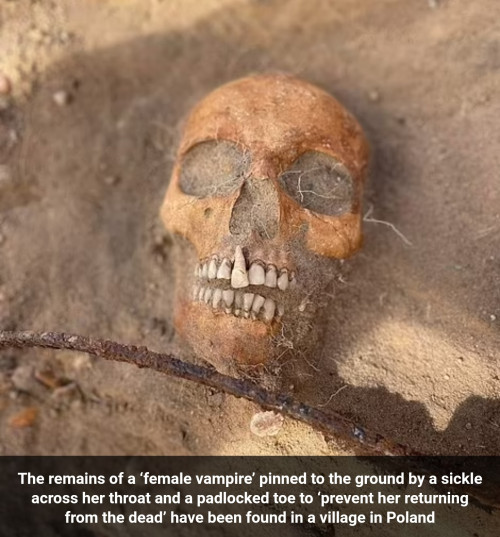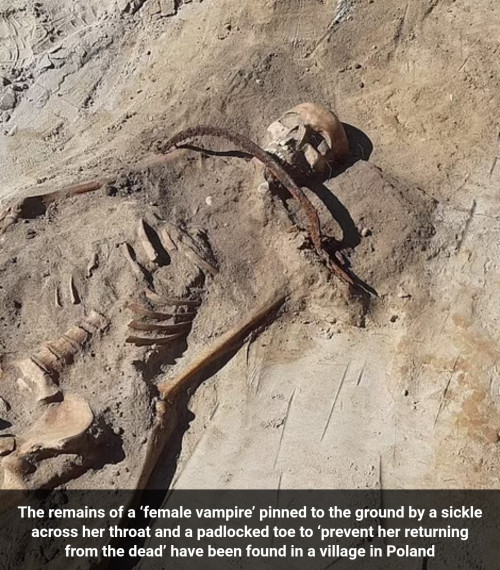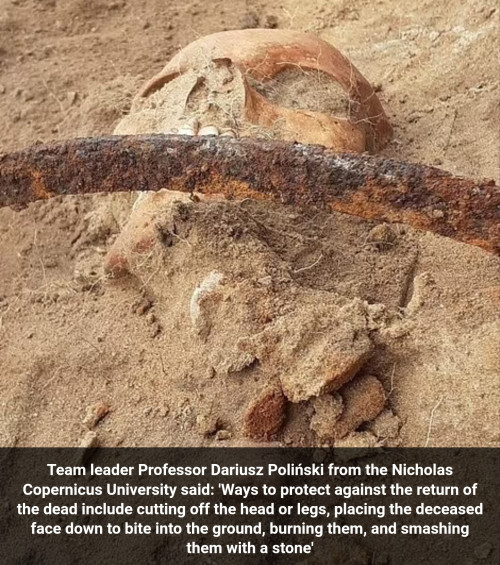- Joined
- Feb 26, 2019
- Messages
- 12,449
- Points
- 113
EXCLUSIVE: Remains of a female 'VAMPIRE' pinned to the ground with a sickle across her throat to prevent her returning from the dead are found in Poland
- The remains were found during archaeological work at a 17th century cemetery in the village of Pien, Poland
- Professor Dariusz Poliński said sickle was placed over the neck to 'protect against the return of the dead'
- In addition to the sickle, the skeleton was found with a padlocked toe as another precautionary measure
- Researchers also found a silk cap on its head, indicating she had held a high social status
- Poliński said other measures used at the time would have involved cutting off the head and legs
PUBLISHED: 15:02 BST, 2 September 2022 | UPDATED: 16:54 BST, 2 September 2022
The remains of a 'female vampire' pinned to the ground by a sickle across her throat and a padlocked toe to 'prevent her returning from the dead' have been found in a village in Poland.
Discovered during archaeological work at a 17th century cemetery in the village of Pien, researchers also found the skeletal remains had a silk cap on its head, indicating she had held a high social status, and a protruding tooth.
Team leader Professor Dariusz Poliński from the Nicholas Copernicus University in the nearby city Torun said the form of burial was unusual.



He said: 'Ways to protect against the return of the dead include cutting off the head or legs, placing the deceased face down to bite into the ground, burning them, and smashing them with a stone.
'The sickle was not laid flat but placed on the neck in such a way that if the deceased had tried to get up most likely the head would have been cut off or injured.'
He added that the padlocked big toe on the skeleton's left foot likely symbolised 'the closing of a stage and the impossibility of returning.'
Records of myths about the undead date back as far as the 11th century in Easter Europe. People feared that some who were buried would claw their way back up to the surface as blood-sucking monsters, and terrorise the living.
It is not uncommon the region to find burial sites where a metal rod - or a steak - have been hammered through the skull of the deceased. People at the time believed this was one way to ensuring the person stayed dead.
In some parts of the continent - particularly among Slavic people - belief in the legends of vampires became so wide-spread that it caused mass hysteria, and even led to executions of people thought to be vampires.
People who died in untimely ways - such as through suicide - would also often have been suspected of vampirism, and their bodies would have been mutilated to prevent them from rising from the dead.
In 2015, archaeologists in the village of Drewsko 130 miles away found five skeletons buried in a similar manner at a 400-year-old cemetery.
